2013 NISSAN FRONTIER lock
[x] Cancel search: lockPage 403 of 444
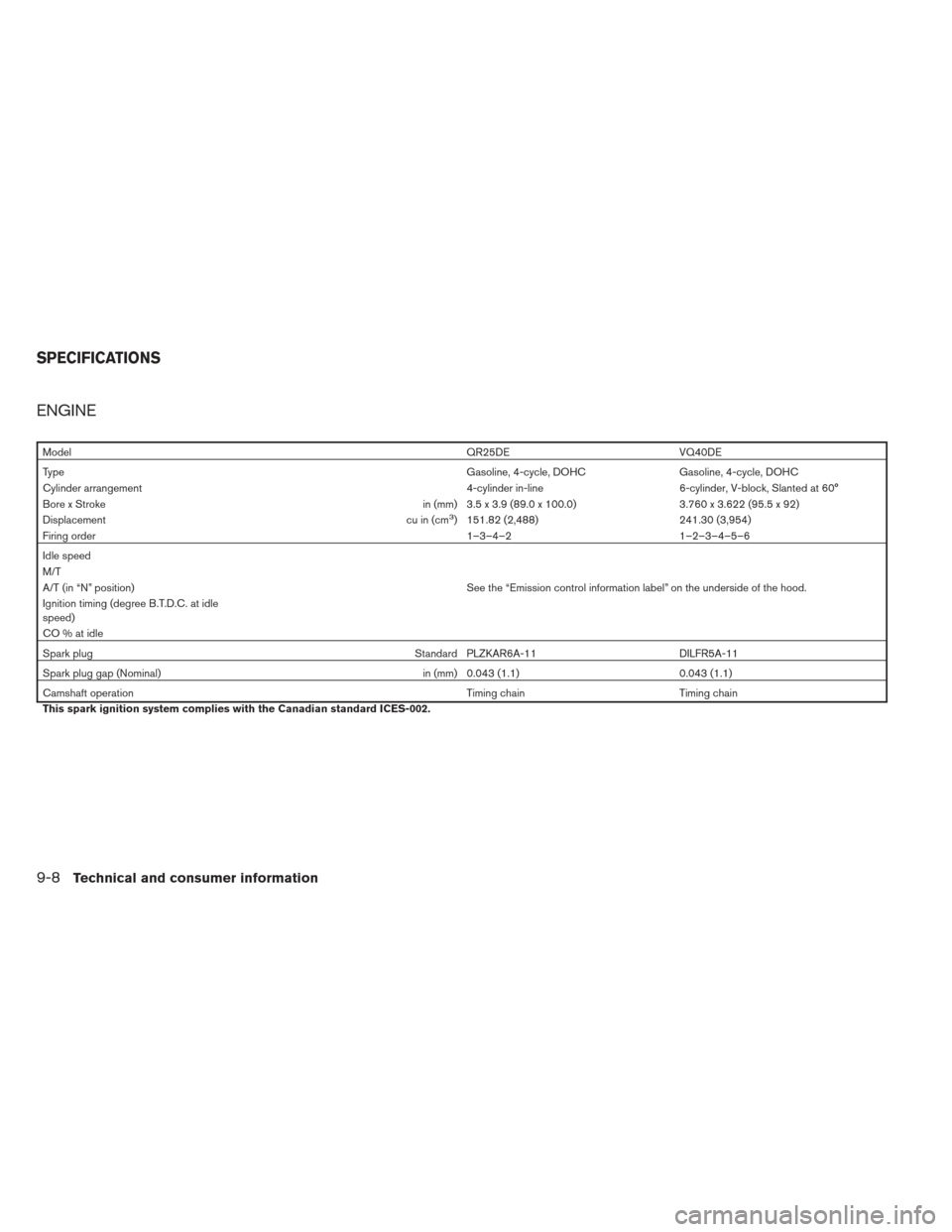
ENGINE
ModelQR25DE VQ40DE
Type Gasoline, 4-cycle, DOHC Gasoline, 4-cycle, DOHC
Cylinder arrangement 4-cylinder in-line6-cylinder, V-block, Slanted at 60°
Bore x Stroke in (mm) 3.5 x 3.9 (89.0 x 100.0)3.760 x 3.622 (95.5 x 92)
Displacement cu in (cm
3) 151.82 (2,488)241.30 (3,954)
Firing order 1–3–4–21–2–3–4–5–6
Idle speed
M/T
A/T (in “N” position) See the “Emission control information label” on the underside of the hood.
Ignition timing (degree B.T.D.C. at idle
speed)
CO%atidle
Spark plug Standard PLZKAR6A-11DILFR5A-11
Spark plug gap (Nominal) in (mm) 0.043 (1.1)0.043 (1.1)
Camshaft operation Timing chainTiming chain
This spark ignition system complies with the Canadian standard ICES-002.
SPECIFICATIONS
9-8Technical and consumer information
Page 413 of 444
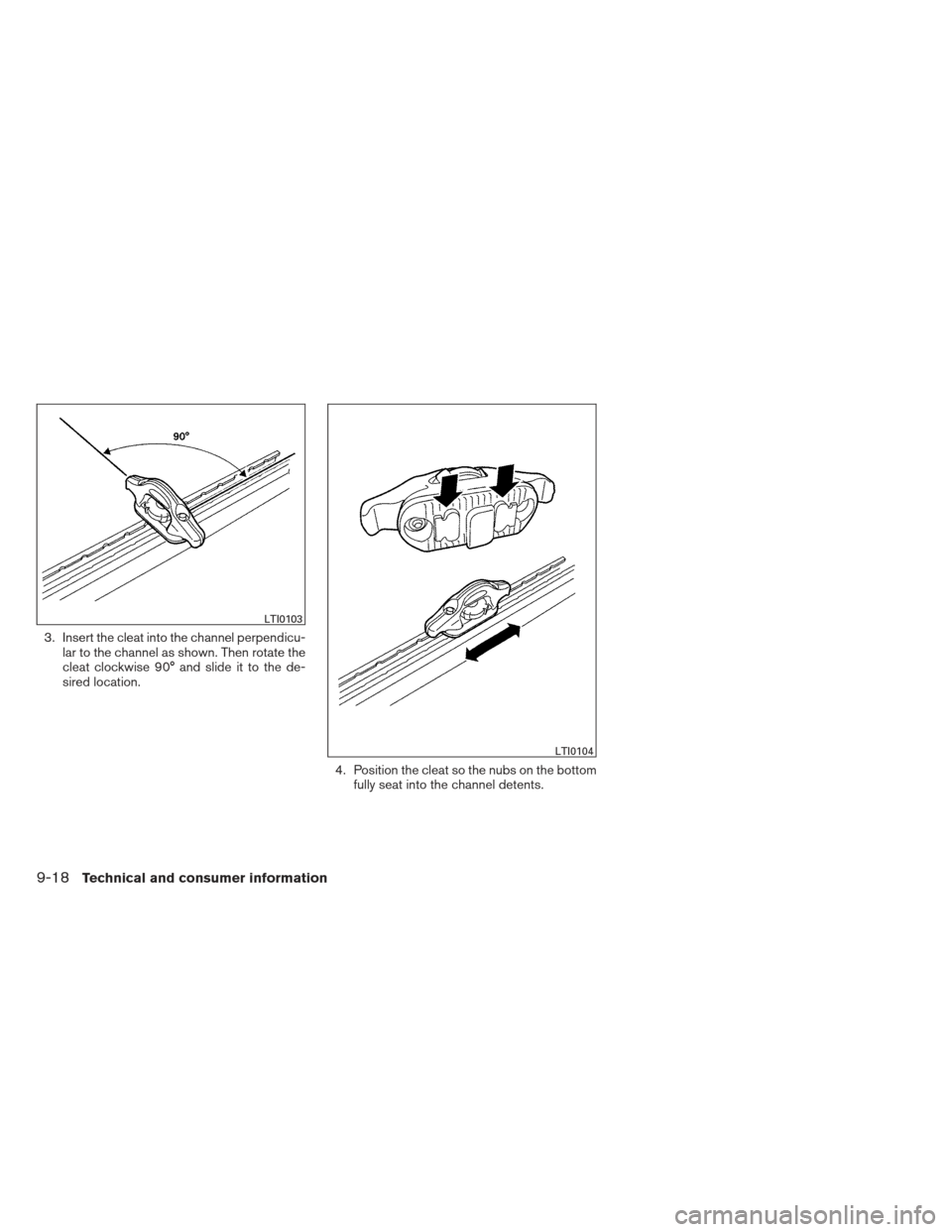
3. Insert the cleat into the channel perpendicu-lar to the channel as shown. Then rotate the
cleat clockwise 90° and slide it to the de-
sired location.
4. Position the cleat so the nubs on the bottomfully seat into the channel detents.
LTI0103
LTI0104
9-18Technical and consumer information
Page 424 of 444
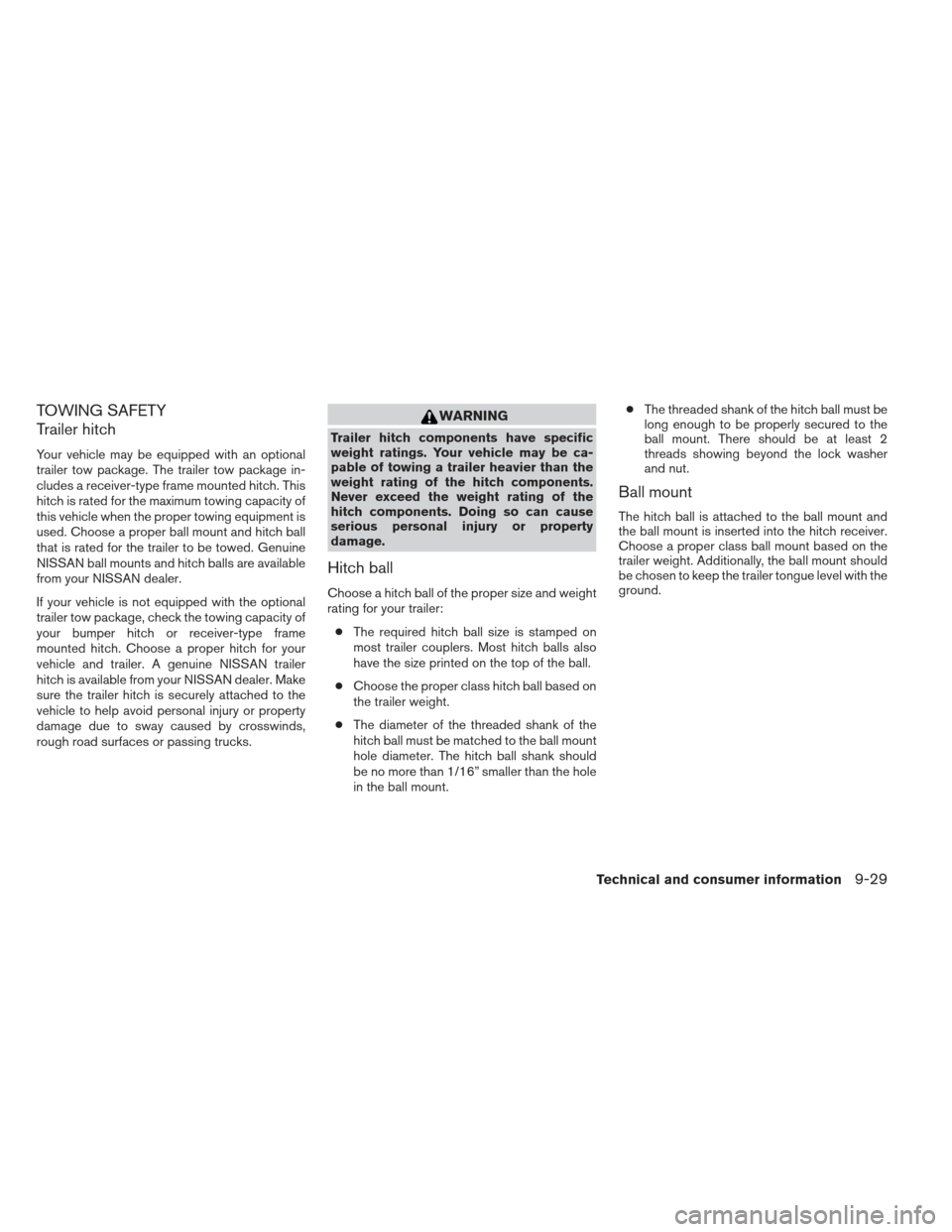
TOWING SAFETY
Trailer hitch
Your vehicle may be equipped with an optional
trailer tow package. The trailer tow package in-
cludes a receiver-type frame mounted hitch. This
hitch is rated for the maximum towing capacity of
this vehicle when the proper towing equipment is
used. Choose a proper ball mount and hitch ball
that is rated for the trailer to be towed. Genuine
NISSAN ball mounts and hitch balls are available
from your NISSAN dealer.
If your vehicle is not equipped with the optional
trailer tow package, check the towing capacity of
your bumper hitch or receiver-type frame
mounted hitch. Choose a proper hitch for your
vehicle and trailer. A genuine NISSAN trailer
hitch is available from your NISSAN dealer. Make
sure the trailer hitch is securely attached to the
vehicle to help avoid personal injury or property
damage due to sway caused by crosswinds,
rough road surfaces or passing trucks.
WARNING
Trailer hitch components have specific
weight ratings. Your vehicle may be ca-
pable of towing a trailer heavier than the
weight rating of the hitch components.
Never exceed the weight rating of the
hitch components. Doing so can cause
serious personal injury or property
damage.
Hitch ball
Choose a hitch ball of the proper size and weight
rating for your trailer:● The required hitch ball size is stamped on
most trailer couplers. Most hitch balls also
have the size printed on the top of the ball.
● Choose the proper class hitch ball based on
the trailer weight.
● The diameter of the threaded shank of the
hitch ball must be matched to the ball mount
hole diameter. The hitch ball shank should
be no more than 1/16” smaller than the hole
in the ball mount. ●
The threaded shank of the hitch ball must be
long enough to be properly secured to the
ball mount. There should be at least 2
threads showing beyond the lock washer
and nut.
Ball mount
The hitch ball is attached to the ball mount and
the ball mount is inserted into the hitch receiver.
Choose a proper class ball mount based on the
trailer weight. Additionally, the ball mount should
be chosen to keep the trailer tongue level with the
ground.
Technical and consumer information9-29
Page 428 of 444
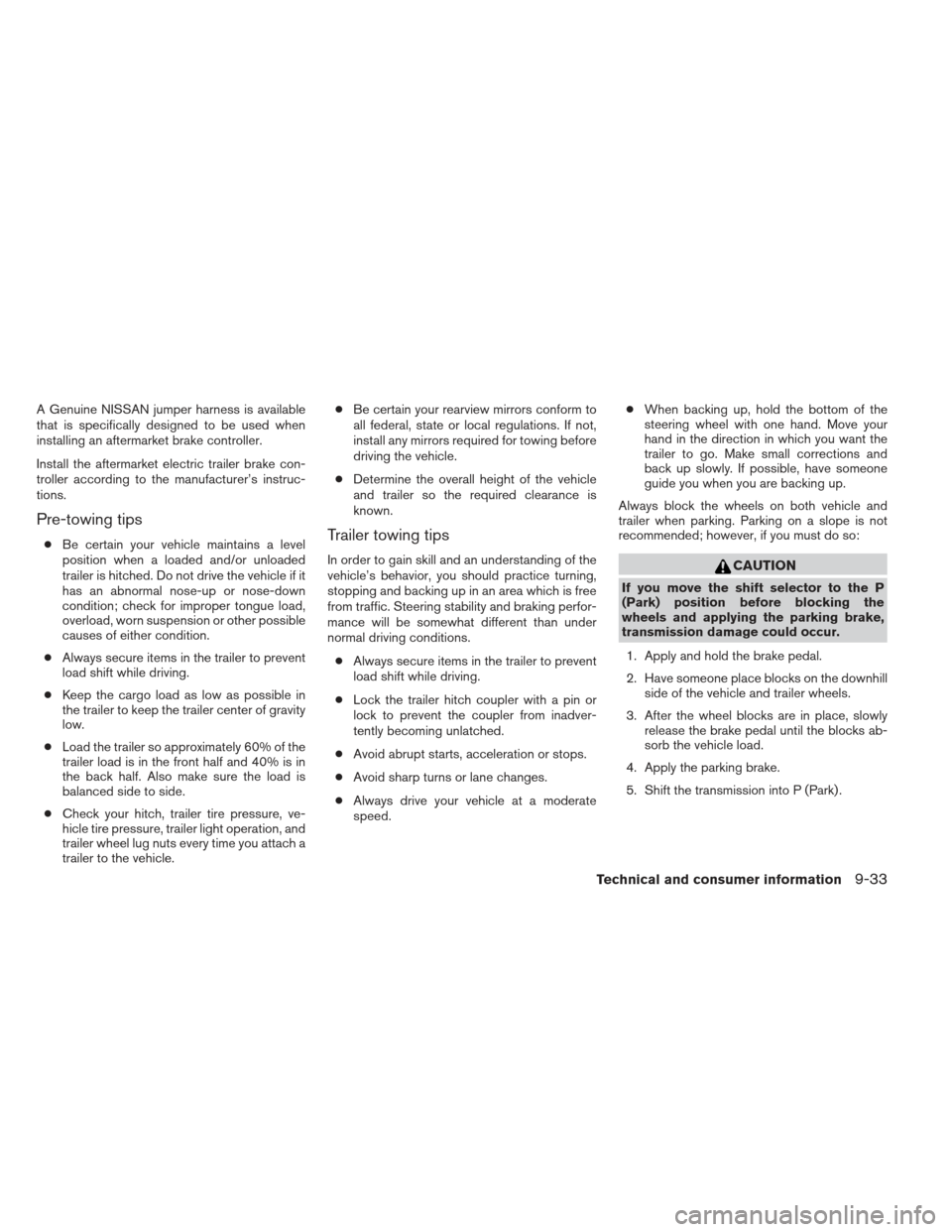
A Genuine NISSAN jumper harness is available
that is specifically designed to be used when
installing an aftermarket brake controller.
Install the aftermarket electric trailer brake con-
troller according to the manufacturer’s instruc-
tions.
Pre-towing tips
●Be certain your vehicle maintains a level
position when a loaded and/or unloaded
trailer is hitched. Do not drive the vehicle if it
has an abnormal nose-up or nose-down
condition; check for improper tongue load,
overload, worn suspension or other possible
causes of either condition.
● Always secure items in the trailer to prevent
load shift while driving.
● Keep the cargo load as low as possible in
the trailer to keep the trailer center of gravity
low.
● Load the trailer so approximately 60% of the
trailer load is in the front half and 40% is in
the back half. Also make sure the load is
balanced side to side.
● Check your hitch, trailer tire pressure, ve-
hicle tire pressure, trailer light operation, and
trailer wheel lug nuts every time you attach a
trailer to the vehicle. ●
Be certain your rearview mirrors conform to
all federal, state or local regulations. If not,
install any mirrors required for towing before
driving the vehicle.
● Determine the overall height of the vehicle
and trailer so the required clearance is
known.Trailer towing tips
In order to gain skill and an understanding of the
vehicle’s behavior, you should practice turning,
stopping and backing up in an area which is free
from traffic. Steering stability and braking perfor-
mance will be somewhat different than under
normal driving conditions.
● Always secure items in the trailer to prevent
load shift while driving.
● Lock the trailer hitch coupler with a pin or
lock to prevent the coupler from inadver-
tently becoming unlatched.
● Avoid abrupt starts, acceleration or stops.
● Avoid sharp turns or lane changes.
● Always drive your vehicle at a moderate
speed. ●
When backing up, hold the bottom of the
steering wheel with one hand. Move your
hand in the direction in which you want the
trailer to go. Make small corrections and
back up slowly. If possible, have someone
guide you when you are backing up.
Always block the wheels on both vehicle and
trailer when parking. Parking on a slope is not
recommended; however, if you must do so:CAUTION
If you move the shift selector to the P
(Park) position before blocking the
wheels and applying the parking brake,
transmission damage could occur.
1. Apply and hold the brake pedal.
2. Have someone place blocks on the downhill side of the vehicle and trailer wheels.
3. After the wheel blocks are in place, slowly release the brake pedal until the blocks ab-
sorb the vehicle load.
4. Apply the parking brake.
5. Shift the transmission into P (Park) .
Technical and consumer information9-33
Page 429 of 444
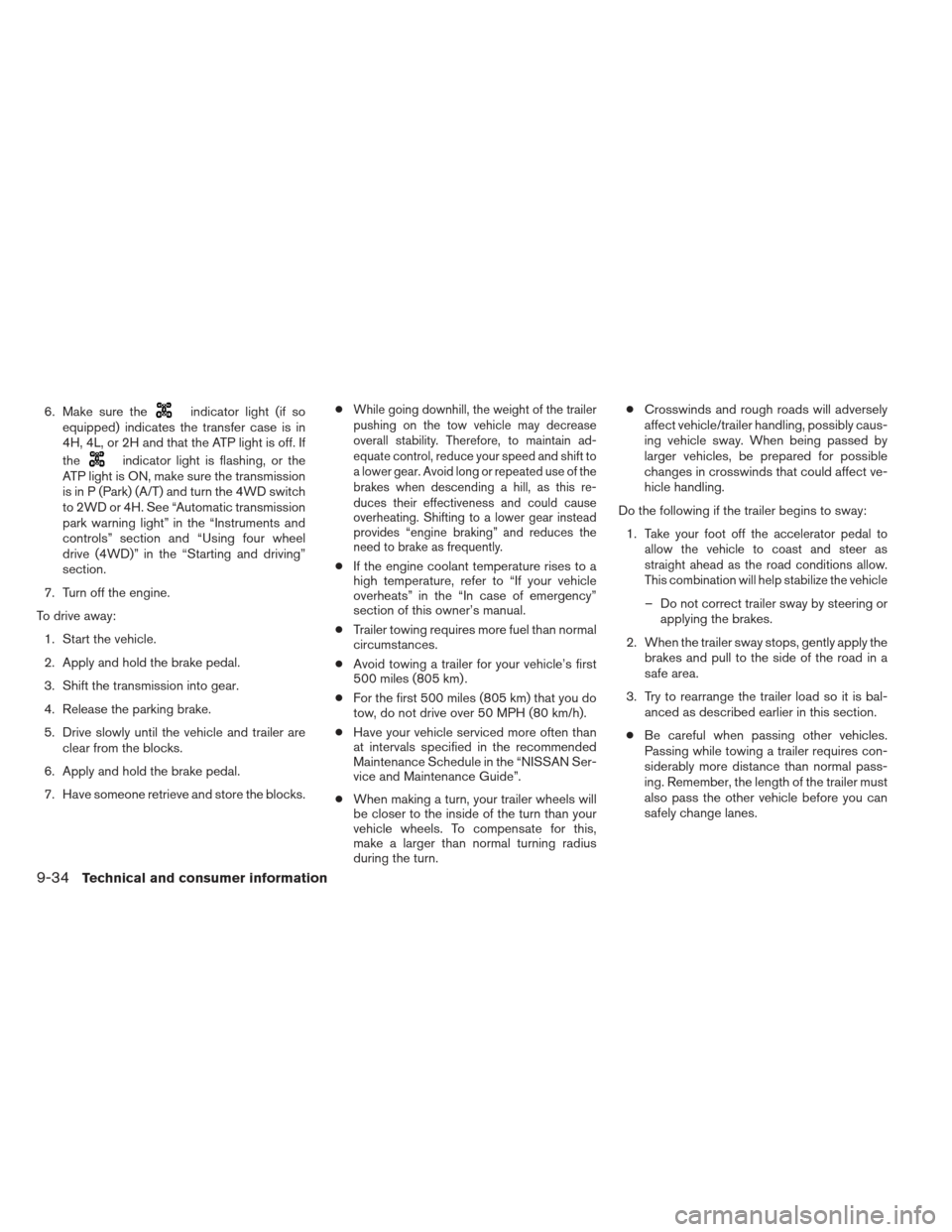
6. Make sure theindicator light (if so
equipped) indicates the transfer case is in
4H, 4L, or 2H and that the ATP light is off. If
the
indicator light is flashing, or the
ATP light is ON, make sure the transmission
is in P (Park) (A/T) and turn the 4WD switch
to 2WD or 4H. See “Automatic transmission
park warning light” in the “Instruments and
controls” section and “Using four wheel
drive (4WD)” in the “Starting and driving”
section.
7. Turn off the engine.
To drive away: 1. Start the vehicle.
2. Apply and hold the brake pedal.
3. Shift the transmission into gear.
4. Release the parking brake.
5. Drive slowly until the vehicle and trailer are clear from the blocks.
6. Apply and hold the brake pedal.
7. Have someone retrieve and store the blocks. ●
While going downhill, the weight of the trailer
pushing on the tow vehicle may decrease
overall stability. Therefore, to maintain ad-
equate control, reduce your speed and shift to
a lower gear. Avoid long or repeated use of the
brakes when descending a hill, as this re-
duces their effectiveness and could cause
overheating. Shifting to a lower gear instead
provides “engine braking” and reduces the
need to brake as frequently.
● If the engine coolant temperature rises to a
high temperature, refer to “If your vehicle
overheats” in the “In case of emergency”
section of this owner’s manual.
● Trailer towing requires more fuel than normal
circumstances.
● Avoid towing a trailer for your vehicle’s first
500 miles (805 km) .
● For the first 500 miles (805 km) that you do
tow, do not drive over 50 MPH (80 km/h).
● Have your vehicle serviced more often than
at intervals specified in the recommended
Maintenance Schedule in the “NISSAN Ser-
vice and Maintenance Guide”.
● When making a turn, your trailer wheels will
be closer to the inside of the turn than your
vehicle wheels. To compensate for this,
make a larger than normal turning radius
during the turn. ●
Crosswinds and rough roads will adversely
affect vehicle/trailer handling, possibly caus-
ing vehicle sway. When being passed by
larger vehicles, be prepared for possible
changes in crosswinds that could affect ve-
hicle handling.
Do the following if the trailer begins to sway: 1.
Take your foot off the accelerator pedal to
allow the vehicle to coast and steer as
straight ahead as the road conditions allow.
This combination will help stabilize the vehicle
– Do not correct trailer sway by steering or applying the brakes.
2. When the trailer sway stops, gently apply the brakes and pull to the side of the road in a
safe area.
3. Try to rearrange the trailer load so it is bal- anced as described earlier in this section.
● Be careful when passing other vehicles.
Passing while towing a trailer requires con-
siderably more distance than normal pass-
ing. Remember, the length of the trailer must
also pass the other vehicle before you can
safely change lanes.
9-34Technical and consumer information
Page 436 of 444
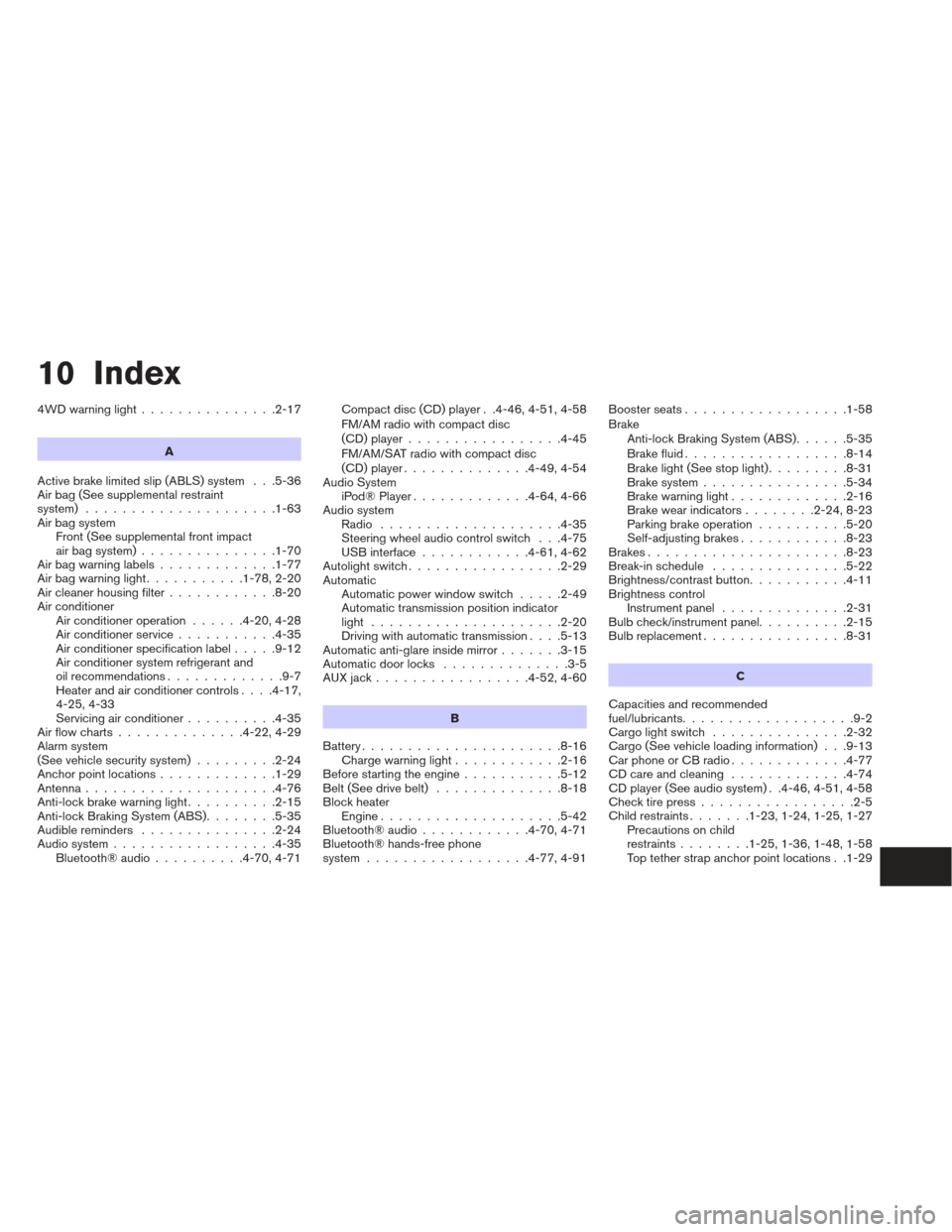
10 Index
4WDwarninglight...............2-17A
Active brake limited slip (ABLS) system . . .5-36
Air bag (See supplemental restraint
system) .....................1-63
Air bag system Front (See supplemental front impact
air bag system) ...............1-70
Airbagwarninglabels.............1-77
Airbagwarninglight...........1-78,2-20
Air cleaner housing filter ............8-20
Air conditioner Air conditioner operation ......4-20,4-28
Air conditioner service ...........4-35
Air conditioner specification label .....9-12
Air conditioner system refrigerant and
oil recommendations .............9-7
Heater and air conditioner controls ....4-17,
4-25, 4-33
Servicing air conditioner ..........4-35
Airflowcharts..............4-22,4-29
Alarm system
(See vehicle security system) .........2-24
Anchor point locations .............1-29
Antenna.....................4-76
Anti-lock brake warning light ..........2-15
Anti-lock Braking System (ABS) ........5-35
Audible reminders ...............2-24
Audio system ..................4-35
Bluetooth®audio..........4-70,4-71 Compact disc (CD) player . .4-46, 4-51, 4-58
FM/AM radio with compact disc
(CD) player
.................4-45
FM/AM/SAT radio with compact disc
(CD) player ..............4-49,4-54
Audio System iPod®Player.............4-64,4-66
Audio system Radio ....................4-35
Steering wheel audio control switch . . .4-75
USB interface ............4-61,4-62
Autolight switch .................2-29
Automatic Automatic power window switch .....2-49
Automatic transmission position indicator
light .....................2-20
Driving with automatic transmission ....5-13
Automatic anti-glare inside mirror .......3-15
Automatic door locks ..............3-5
AUXjack.................4-52,4-60
B
Battery ......................8-16
Chargewarninglight............2-16
Before starting the engine ...........5-12
Belt (See drive belt) ..............8-18
Block heater Engine ....................5-42
Bluetooth®audio............4-70,4-71
Bluetooth® hands-free phone
system ..................4-77,4-91 Boosterseats..................1-58
Brake
Anti-lock Braking System (ABS) ......5-35
Brakefluid..................8-14
Brakelight(Seestoplight).........8-31
Brake system ................5-34
Brake warning light .............2-16
Brake wear indicators ........2-24,8-23
Parking brake operation ..........5-20
Self-adjusting brakes ............8-23
Brakes ......................8-23
Break-inschedule ...............5-22
Brightness/contrast button ...........4-11
Brightness control Instrument panel ..............2-31
Bulb check/instrument panel ..........2-15
Bulbreplacement................8-31
C
Capacities and recommended
fuel/lubricants ...................9-2
Cargolightswitch ...............2-32
Cargo (See vehicle loading information) . . .9-13
CarphoneorCBradio.............4-77
CDcareandcleaning .............4-74
CD player (See audio system) . .4-46, 4-51, 4-58
Check tire press .................2-5
Child restraints .......1-23,1-24,1-25,1-27
Precautions
on child
restraints ........1-25,1-36,1-48,1-58
Top tether strap anchor point locations . .1-29
Page 437 of 444
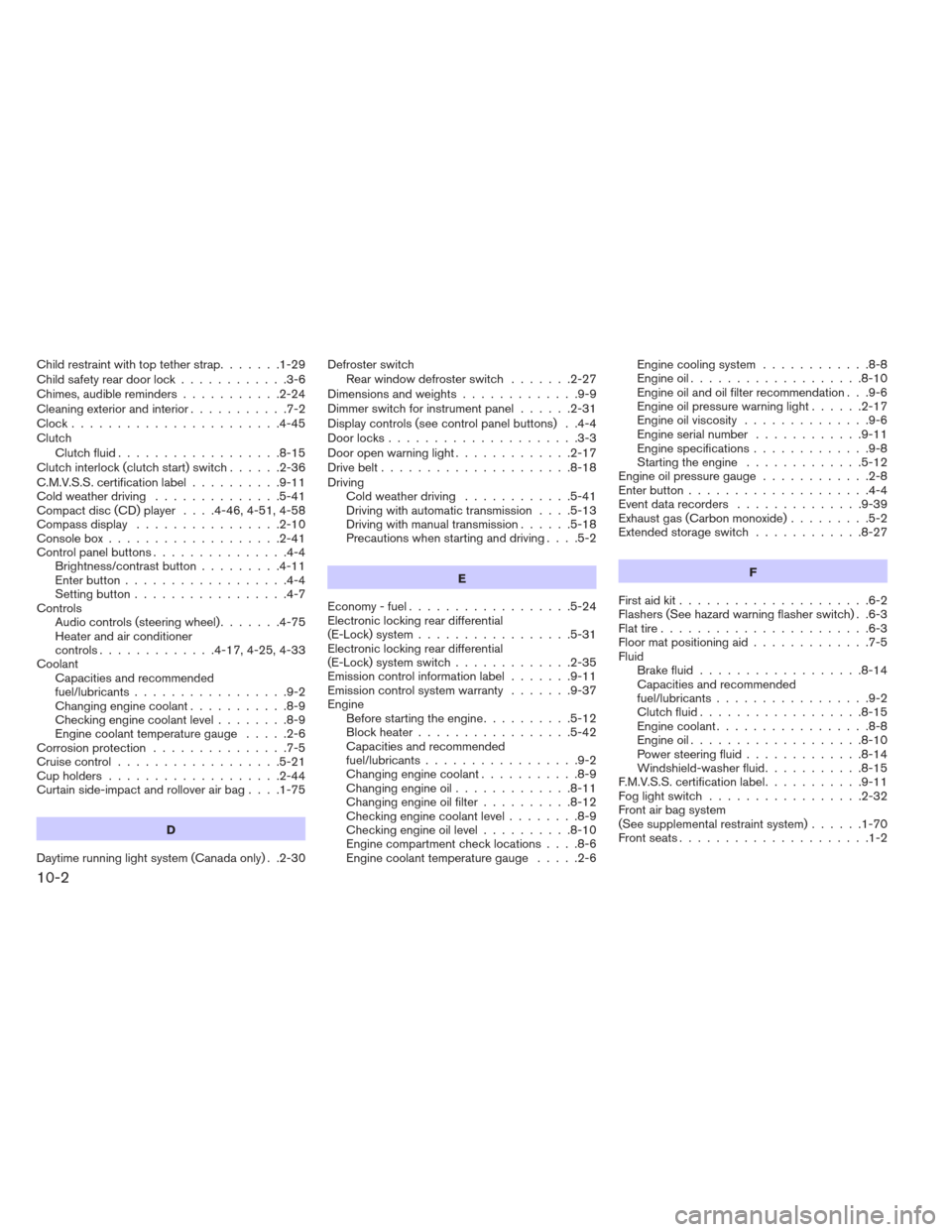
Child restraint with top tether strap.......1-29
Child safety rear door lock ............3-6
Chimes, audible reminders ...........2-24
Cleaningexteriorandinterior...........7-2
Clock.......................4-45
Clutch Clutchfluid..................8-15
Clutchinterlock(clutchstart)switch......2-36
C.M.V.S.S. certification label ..........9-11
Cold weather driving ..............5-41
Compact disc (CD) player ....4-46,4-51,4-58
Compass display ................2-10
Console box ...................2-41
Controlpanelbuttons...............4-4 Brightness/contrast button .........4-11
Enterbutton..................4-4
Setting button .................4-7
Controls Audiocontrols(steeringwheel).......4-75
Heater and air conditioner
controls .............4-17,4-25,4-33
Coolant Capacities and recommended
fuel/lubricants .................9-2
Changing engine coolant ...........8-9
Checking engine coolant level ........8-9
Engine coolant temperature gauge .....2-6
Corrosionprotection ...............7-5
Cruise control ..................5-21
Cupholders...................2-44
Curtain side-impact and rollover air bag ....1-75
D
Daytime running light system (Canada only) . .2-30 Defroster switch
Rear window defroster switch .......2-27
Dimensionsandweights.............9-9
Dimmer switch for instrument panel ......2-31
Display controls (see control panel buttons) . .4-4
Door locks .....................3-3
Door open warning light .............2-17
Drive belt .....................8-18
Driving Cold weather driving ............5-41
Driving with automatic transmission ....5-13
Driving with manual transmission ......5-18
Precautions when starting and driving ....5-2
E
Economy - fuel ..................5-24
Electronic locking rear differential
(E-Lock) system .................5-31
Electronic locking rear differential
(E-Lock) system switch .............2-35
Emission control information label .......9-11
Emission control system warranty .......9-37
Engine Before starting the engine ..........5-12
Block heater .................5-42
Capacities and recommended
fuel/lubricants .................9-2
Changing engine coolant ...........8-9
Changing engine oil .............8-11
Changing engine oil filter ..........8-12
Checking engine coolant level ........8-9
Checking engine oil level ..........8-10
Engine compartment check locations ....8-6
Engine coolant temperature gauge .....2-6Engine cooling system
............8-8
Engine oil ...................8-10
Engine oil and oil filter recommendation . . .9-6
Engine oil pressure warning light ......2-17
Engine oil viscosity ..............9-6
Engine
serial number ............9-11
Engine specifications .............9-8
Starting the engine .............5-12
Engine oil pressure gauge ............2-8
Enterbutton....................4-4
Eventdatarecorders ..............9-39
Exhaust gas (Carbon monoxide) .........5-2
Extended storage switch ............8-27
F
First aid kit .....................6-2
Flashers (See hazard warning flasher switch) . .6-3
Flat tire .......................6-3
Floor mat positioning aid .............7-5
Fluid Brake fluid ..................8-14
Capacities and recommended
fuel/lubricants .................9-2
Clutch fluid ..................8-15
Engine coolant .................8-8
Engine oil ...................8-10
Power steering fluid .............8-14
Windshield-washer fluid ...........8-15
F.M.V.S.S. certification label ...........9-11
Foglightswitch .................2-32
Front air bag system
(See supplemental restraint system) ......1-70
Front seats .....................1-2
10-2
Page 439 of 444
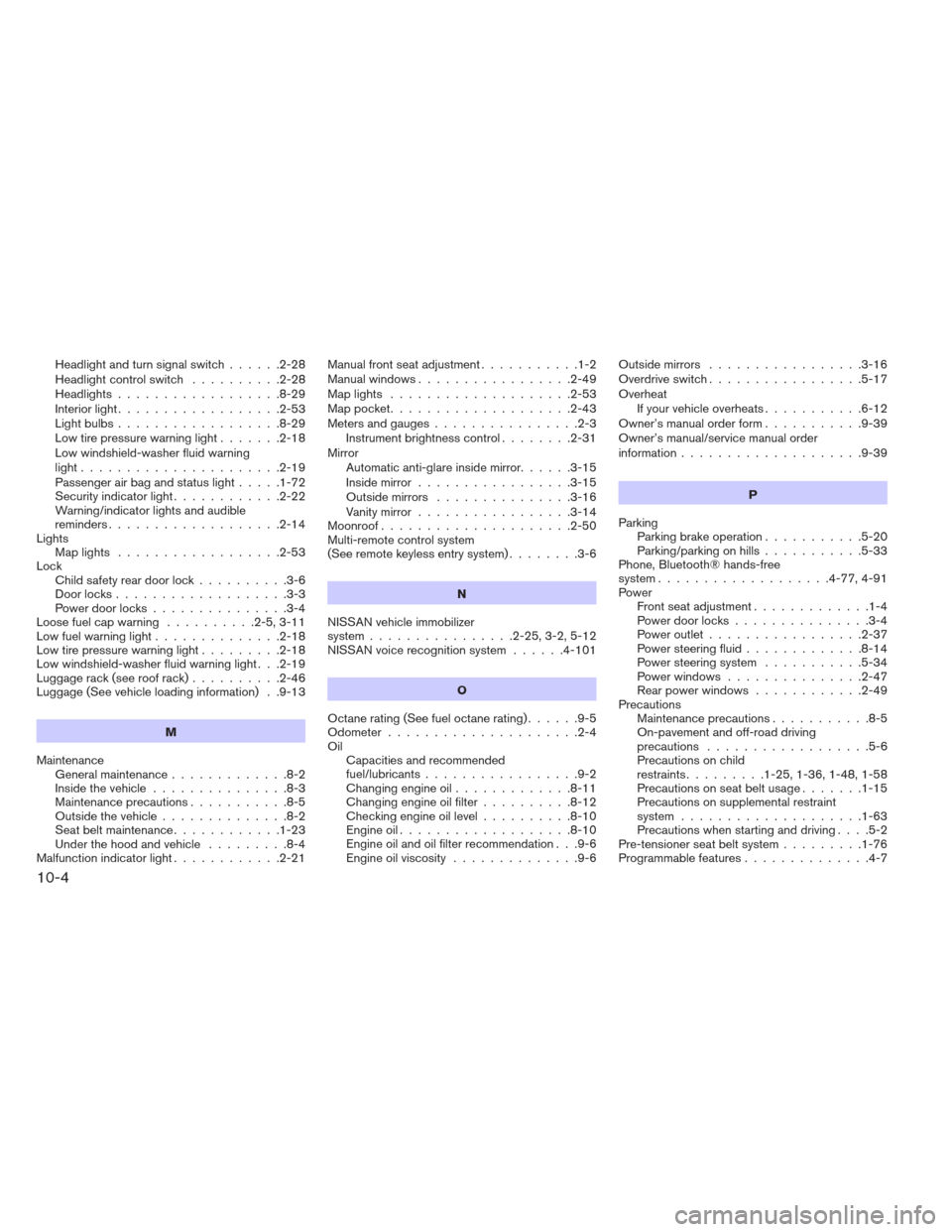
Headlight and turn signal switch......2-28
Headlightcontrolswitch ..........2-28
Headlights..................8-29
Interiorlight..................2-53
Lightbulbs..................8-29
Low tire pressure warning light .......2-18
Low windshield-washer fluid warning
light......................2-19
Passenger air bag and status light .....1-72
Security indicator light ............2-22
Warning/indicator lights and audible
reminders ...................2-14
Lights Maplights ..................2-53
Lock Child safety rear door lock ..........3-6
Door locks ...................3-3
Power door locks ...............3-4
Loose fuel cap warning ..........2-5,3-11
Lowfuelwarninglight..............2-18
Low tire pressure warning light .........2-18
Low windshield-washer fluid warning light . . .2-19
Luggage rack (see roof rack) ..........2-46
Luggage (See vehicle loading information) . .9-13
M
Maintenance Generalmaintenance.............8-2
Insidethevehicle...............8-3
Maintenanceprecautions...........8-5
Outsidethevehicle..............8-2
Seat belt maintenance ............1-23
Under the hood and vehicle .........8-4
Malfunction indicator light ............2-21 Manual front seat adjustment
...........1-2
Manual windows .................2-49
Maplights ....................2-53
Map pocket ....................2-43
Meters and gauges ................2-3
Instrument brightness control ........2-31
Mirror Automatic anti-glare inside mirror ......3-15
Inside mirror .................3-15
Outside mirrors ...............3-16
Vanity mirror .................3-14
Moonroof .....................2-50
Multi-remote control system
(See remote keyless entry system) ........3-6
N
NISSAN vehicle immobilizer
system ................2-25,3-2,5-12
NISSAN voice recognition system ......4-101
O
Octane rating (See fuel octane rating) ......9-5
Odometer .....................2-4
Oil Capacities and recommended
fuel/lubricants .................9-2
Changing engine oil .............8-11
Changing engine oil filter ..........8-12
Checking engine oil level ..........8-10
Engineoil...................8-10
Engine oil and oil filter recommendation . . .9-6
Engine oil viscosity ..............9-6 Outside mirrors
.................3-16
Overdrive switch .................5-17
Overheat If your vehicle overheats ...........6-12
Owner’s manual order form ...........9-39
Owner’s manual/service manual order
information ....................9-39
P
Parking Parking brake operation ...........5-20
Parking/parking on hills ...........5-33
Phone, Bluetooth® hands-free
system ...................4-77,4-91
Power Frontseatadjustment.............1-4
Power door locks ...............3-4
Power outlet .................
2-37
Power steering fluid .............8-14
Power steering system ...........5-34
Power windows ...............2-47
Rear power windows ............2-49
Precautions Maintenanceprecautions...........8-5
On-pavement and off-road driving
precautions ..................5-6
Precautions on child
restraints .........1-25,1-36,1-48,1-58
Precautions on seat belt usage .......1-15
Precautions on supplemental restraint
system ....................1-63
Precautions when starting and driving ....5-2
Pre-tensioner seat belt system .........1-76
Programmablefeatures..............4-7
10-4